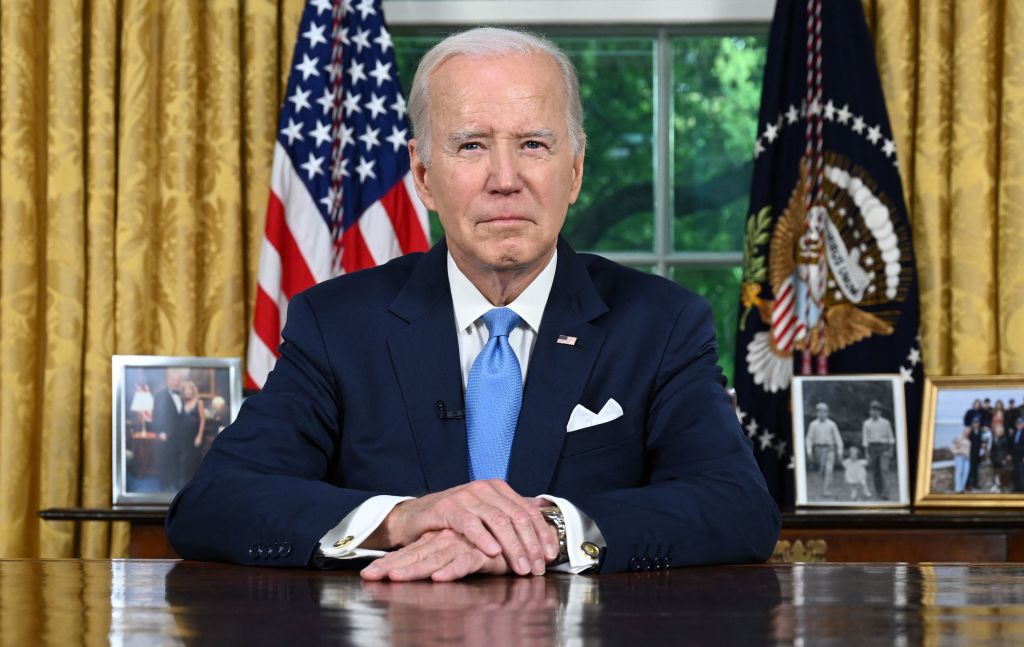
Hoping to impress upon the country how closely the nation veered toward an economically devastating default on its debt, President Biden delivered a live address from the Oval Office to praise the passage of a bipartisan budget deal, making use of one of the most powerful platforms of the presidency for the first time.
Biden broke into primetime television less than 24 hours after Congress had passed the measure to raise the government’s debt ceiling, which he said “averted an economic crisis and an economic collapse.” The legislation, which his administration negotiated over several weeks with House Republican leaders, limits some spending and punts the next time the debt limit is likely to be an issue to the beginning of 2025, after his current term in office is over.
The Senate passed the budget deal late Thursday, after Speaker Kevin McCarthy earlier in the week held together enough House Republicans to pass it. In both chambers, the support for the measure was bipartisan, as was the opposition. Some Democrats thought the deal gave Republicans too much, and in particular expressed frustration at the imposition of new work requirements on people aged 50 to 54 in order to receive food stamps. Some Republicans complained the bill underfunded the military. Others thought that, in general, McCarthy had let Biden off too easily given that the GOP controlled the House.
“No one got everything they wanted but the American people got what they needed,” Biden said.
Along with burnishing Biden’s credentials as a deal maker, the address allowed Biden to remind voters he was following through on his promise to work with Republicans to solve the country’s thorniest problems.
“I want to commend Senator—Speaker McCarthy,” Biden said, briefly flubbing McCarthy’s title. “You know, he and I and our teams, we get along,”
Biden said that when he ran for President, he “was told the days of bipartisanship were over, that Democrats and Republicans no longer worked together. But I refused to believe that.”
“The only way American democracy can function is through compromise and consensus,” he continued. “And that’s what I want to do as your President.”
Read more: Here’s What’s in the Debt Ceiling Deal
As Biden spoke to the nation for 13 minutes, Senior Adviser Anita Dunn seemed to follow along with a copy of the speech on her lap, occasionally taking notes with a pen and taking pains to turn the pages without making a sound that could be picked up by the President’s microphone.
Much of the Oval Office’s furniture had been removed ahead of the live address, and replaced with television cameras and lights, which surrounded the historic Resolute Desk, made from the oak timbers of a British ship and given to President Rutherford B. Hayes by Queen Victoria.
When he was finished and no longer transmitting into homes across the nation, someone said “Clear.” Aides in the room clapped, and the President smiled broadly.
Oval Office addresses are often associated with weighty moments in American history, particularly times of crisis or tragedy. Donald Trump spoke from behind the Resolute Desk when the spread of COVID-19 was declared a global pandemic in March 2020.It was where Ronald Reagan told the country the future “belongs to the brave” after the space shuttle Challenger exploded in 1986.
After the Sept. 11, 2001 attacks, George W. Bush pledged to “make no distinction between the terrorists who committed these acts and those who harbor them.” President Obama addressed the nation from the Oval Office after the San Bernardino terror attacks in 2015, the end of U.S. operations in Iraq, and the BP Deepwater Horizon oil spill in 2010. (After Osama Bin Laden was killed by Navy SEALS, Obama forgoed the cramped Oval, and addressed the country from the East Room, which can hold more people.)
Biden could have chosen to speak from the Oval Office earlier in his presidency, when a CIA drone strike killed al Qaeda leader Ayman al-Zawahri in Kabul, Afghanistan in July 2022. But that live address was given instead from the Truman Balcony of the White House, with a view of the Washington Monument behind him.
Biden picked the Oval Office to discuss the debt ceiling deal because he believes there is a “gravity” to the moment and “he wanted to make sure that the American people understood how important it was to get this done, in a bipartisan way,” said White House Press Secretary Karine Jean-Pierre.
Along with praising the budget deal, Biden made a point of noting that he has signed 350 bipartisan bills so far during his presidency, and touted his work to pass large investments in the nation’s infrastructure project and incentivize microchip manufacturers to open factories in the US.
Biden said he expects to sign the bill lifting the debt limit on Saturday.
More Must-Reads from TIME
- Cybersecurity Experts Are Sounding the Alarm on DOGE
- Meet the 2025 Women of the Year
- The Harsh Truth About Disability Inclusion
- Why Do More Young Adults Have Cancer?
- Colman Domingo Leads With Radical Love
- How to Get Better at Doing Things Alone
- Michelle Zauner Stares Down the Darkness
Contact us at letters@time.com